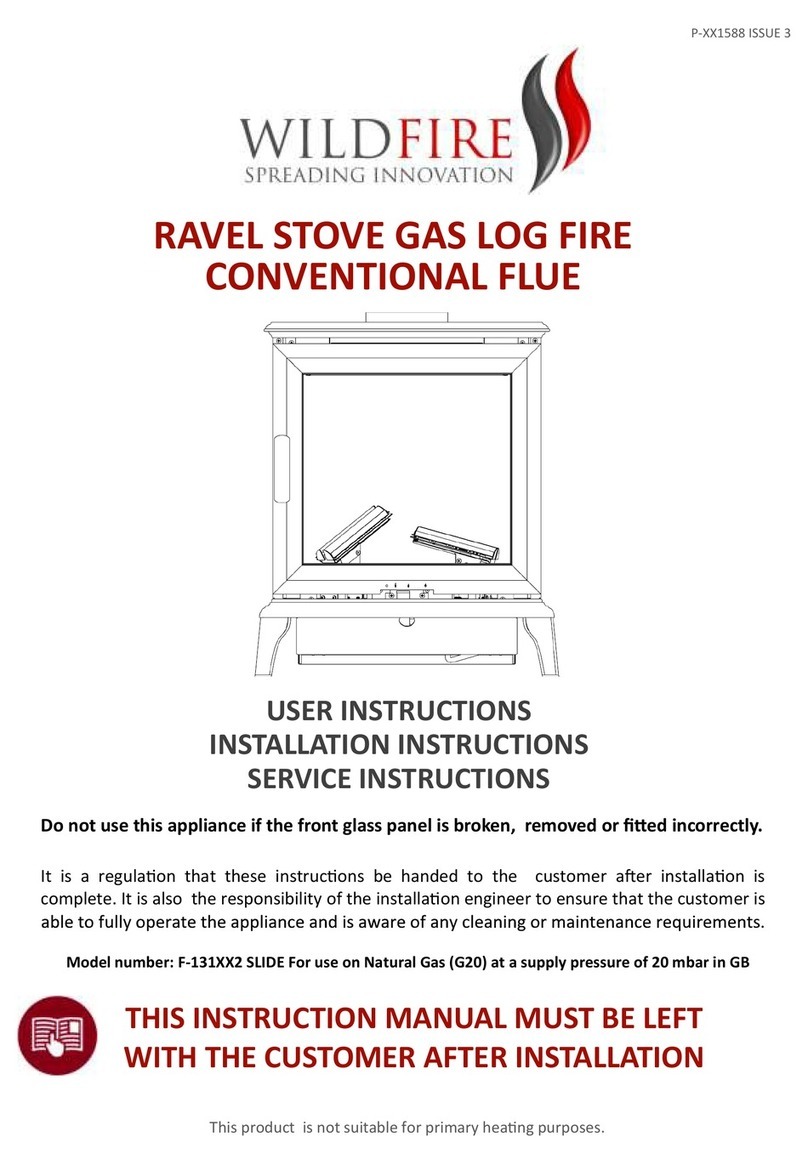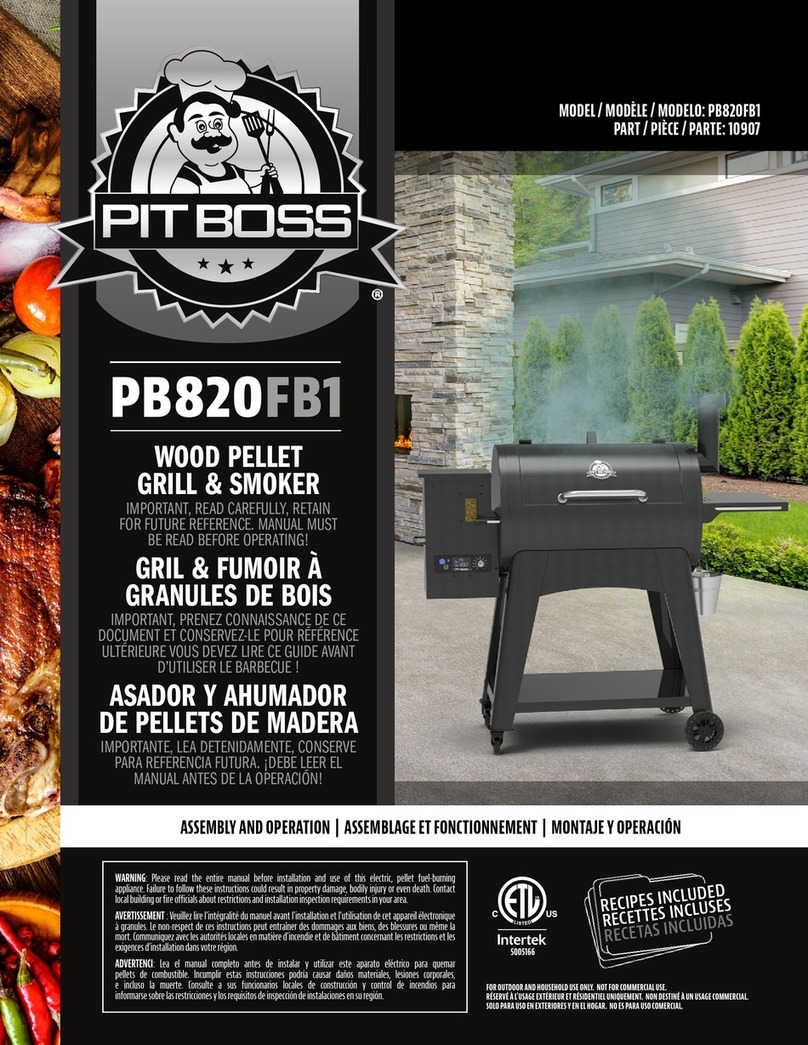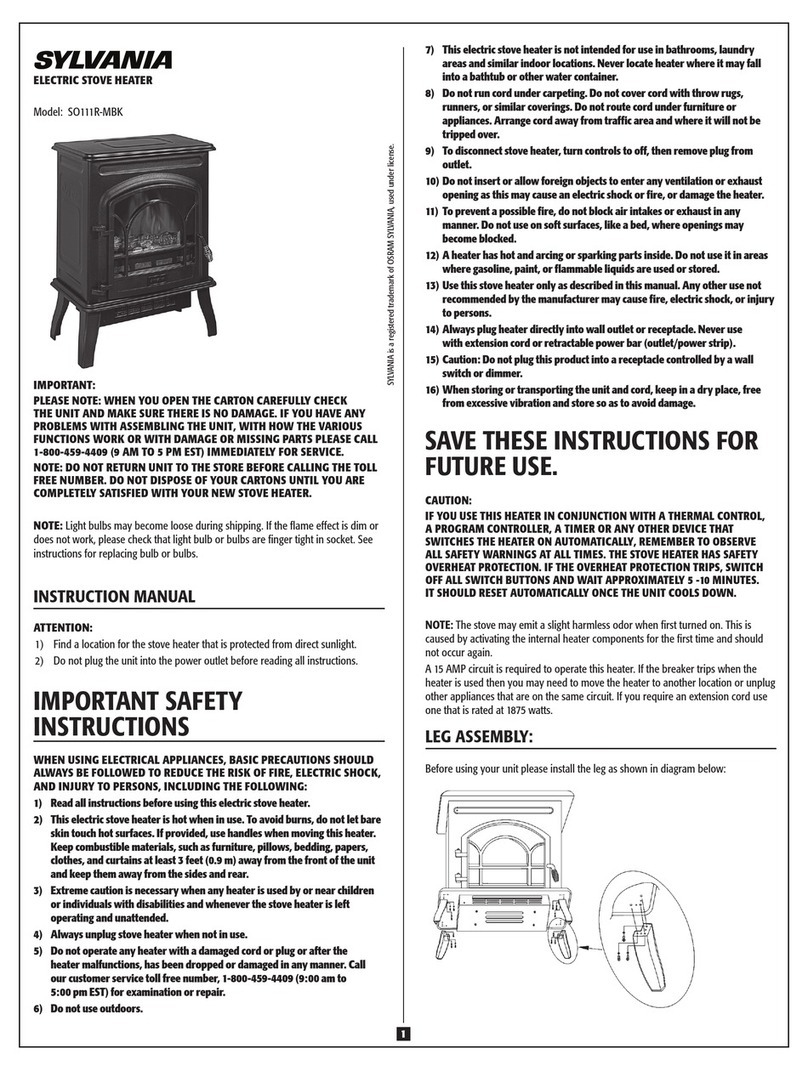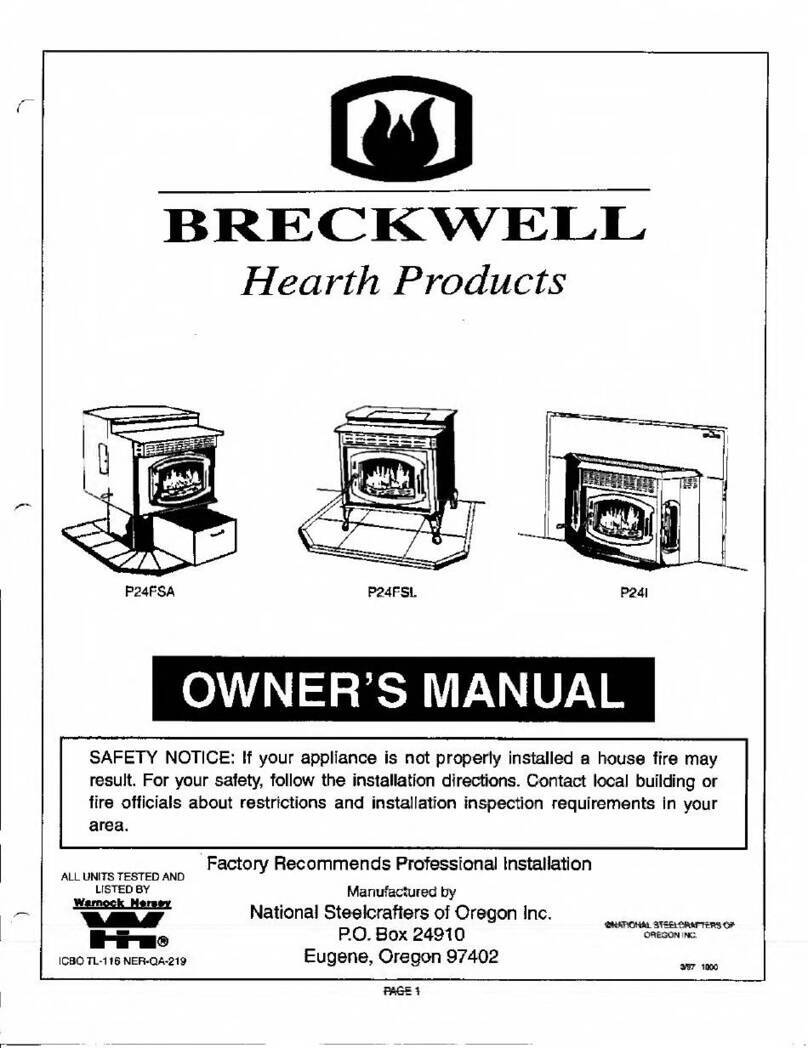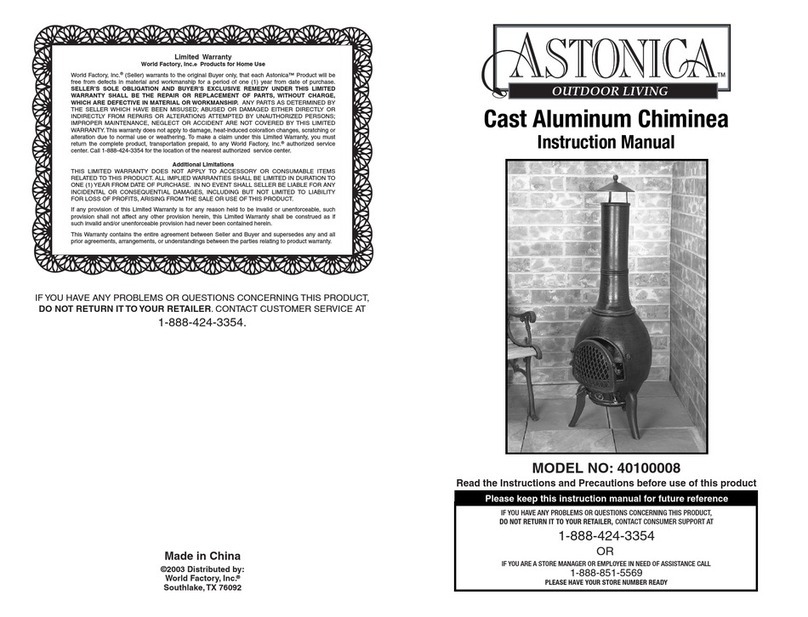
4
Certication label
Serial number of the unit
Here is a COPY of the certication label apposed on each Rafael. You can then examine the contents.
The security label is located on the back panel of the stove.
Manufactured by/
Manufacturé par:
CONTACT YOUR LOCAL BUILDING OR FIRE OFFICIALABOUT RESTRICTIONS AND
INSTALLATION INSPECTION IN YOUR AREA.
CONTACTEZ VOTRE BUREAU DE CONSTRUCTION OU DES INCENDIES AU SUJET DES
RESTRICTIONS ET DE L’INSPECTION DES INSTALLATIONS DANS VOTRE QUARTIER.
Listed Room Heater, Pellet, Corn, Wheat Fuel-Burning Type
Also SUITABLE FOR MOBILE HOME INSTALLATION Pursuant to (UM) 84-HUD
Unité Cataloguées; Pour Combustible Listé, Granule de Bois, Maïs, Blé,
Peut Être UTILISÉE POUR L’INSTALLATION DANS UNE MAISON MOBILE Sous (UM) 84-HUD
‘‘PREVENT HOUSE FIRES’’
Refer to manufactures installation and
operating instruction also.
CAUTION: Special methods are required when
passing chimney through a wall or ceiling.
Follow the pipe manufacturer’s instructions and
local building codes for clearance to combusti-
bles required for the installation of the vent pipe
being used. Do not pass chimney connector
through a combustible surface. Do not connect
this unit to a chimney flue serving another
appliance.
WARNING: (Mobile Home)
Outside air inlet must be provided for combus-
tion and be unrestricted while unit is in use.
NOTE: Remove outside sections of the chim-
ney when displacing the mobile home. Refer to
manual for kit FA01. Outside air is required.
‘‘PRÉVENTION DES FEUX DE MAISON’’
Se référer au manuel d’installation du manufac-
turier et d’instruction.
AVIS: Des méthodes spéciales sont exigées
lorsqu’une cheminée passe à travers d’un mur
ou d’un plafond. Suivez les instructions du man-
ufacturier de tuyau et les codes locaux de con-
struction pour l’espace libre des combustibles
exigé pour l’installation du tuyau de ventilation
en usage. Ne passez pas le tuyau connecteur
de cheminée à travers une surface combusti-
ble. Ne connecter pas cet appareil à un tuyau
de cheminée servant un autre appareil.
ATTENTION: (Maison Mobile)
Une prise d’air extérieur doit être fourni pour
l’entrée du brûleur et doit être sans restriction
lorsque l’unité est en opération.
NOTE: Enlever les sections de la cheminée lors
du transport de la maison mobile. Se référer au
manuel d’instructions pour le kit FA01. A besoin
de l’air extérieur.
Serial No./
Nu. De Serie
Model: Rafael 55
Tested to: ASTM E1509-04, ULC S627-00,
ULC/ORD C1482-M1990
Type of Fuel: Wood Pelletized, Corn, Wheat
WARNING: Only Use Fuel listed above.
Electrical Rating: 120V, 1 amp, 60 Hz
Input Rating: 7,600 to 34000 BTU Typical
NOTE: Replace glass only with 5 mm
ceramic.
Component required for residential and
mobile home installation: Listed multi-fuel
vent type PL and component for outside air
for mobile home. Refer to manual.
DANGER: Risk of electrical shock.
Disconnect power before servicing unit. Do
not route power cord beneath heater.
RA11-0000
Modèle: Rafael 55
Testé à: ASTM E1509-04, ULC S627-00,
ULC/ORD C1482-M1990
Type de Gaz: Granule de Bois, Maïs, Blé
ATTENTION:Utilisé les Combustibles Listé
Évaluation Électrique: 120V, 1 amp, 60 Hz
Évaluation Énergétique: 7,600 to 34000 BTU
Typique
NOTE: Remplacez la vitre avec de la
Céramique de 5mm seulement.
Produits exigés pour l’installation dans une
maison résidentielle et mobile: cheminée
pour multi-combustibles listée PL et une
prise d’air extérieure pour maison mobile.
DANGER: Il y a risque de choc électrique.
Débranchez l’unité avant de faire la mainte-
nance. Ne pas faire passer la corde
électrique en dessous de l’unité.
SEE
NOTE
3”
7.6 CM
6”
15
CM
***8”
20 CM
**3”
7.6 CM
Stove
ADJACENT WALL
30”
76.2 CM
MAX
4”
10 CM 3”
7.6 CM
SEE
NOTE
Stove
6”- 15 CM
*6”
15.2
CM
*6”
15.2
CM
6” - 15.2 CM
FRONT
Stove
NON COMBUSTIBLE
FLOOR PROTECTION
Report No./Rapport Nu.: 120-S-01B-2
INSTALL AND USE ONLY IN ACCORDANCE WITH INSTALLATION AND OPERATING
INSTRUCTION. NOTE: REGARDLESS OF THE STOVE CLEARANCE, VENT PIPE MUST
ALWAYS HAVE A 3” OR 7.6 CM CLEARANCE. USE ONLY MULTI FUEL VENT PIPE TYPE
PL LISTED HAVE 3” TO 4” OR 7.6 TO 10.1 CM INSIDE DIAMETER. CHIMNEYAND
CONNECTOR LISTED FOR MULTI-FUEL VENT ONLY. FLOOR PROTECTION MUST BE
3/8” OR 1 CM MINIMUM THICKNESS NON-COMBUSTIBLE MATERIAL OR EQUIVALENT,
EXTENDING BENEATH HEATER AND TO THE FRONT/SIDES/REAR AS INDICATED.
** SIDE WALL TO UNIT 3” - 7.6 cm
BACK WALL TO UNIT 5” - 12.7 cm
CORNER TO UNIT 4” - 10 cm
*** Unit to sidewall required 8” or 20.3 cm clearance for access to control.
INSTALLER ET UTILISER SEULEMENT CONFORMEMENT AU GUIDE D’INSTALLATION
ET D’INSTRUCTION. NOTE: PEUT IMPORTE L’ESPACE LIBRE DE L’UNITÉ, LE TUYAU
DE LA CHEMINÉE DOIT TOUJOURS AVOIR 3” OU 7.6 CM D’ESPACE LIBRE. UTILISER
SEULEMENT UNE CHEMINÉE DE TYPE PL POUR MULTI-COMBUSTIBLE LISTÉE DE 3”
À 4” OU 7.6 À 10.1 CM DE DIAMÈTRE INTERNE. LA CHEMINEE ET LES CONNECTEURS
DOIVENT ÊTRE LISTÉ POUR MULTI COMBUSTIBLE SEULEMENT. LE PROTECTEUR DE
PLANCHER DOIT ÊTRE 3/8” OU 1 CM D’ÉPAISSEUR MINIMUM DE MATÉRIEL NON-
COMBUSTIBLE OU L’ÉQUIVALENT, S’ÉTENDANT EN DESSOUS DE L’UNITÉ ETAU
DEVANT/CÔTÉS/ARRIÈRE COMME INDIQUÉ.
** MUR DE CÔTÉ À L’UNITÉ 3” - 7.6 cm
MUR ARRIÈRE À L’UNITÉ 5” - 12.7 cm
COIN DE L’UNITÉ À L’UNITÉ 4” - 10 cm
*** 8” ou 20.3 cm est exigé entre l’unité et le mur pour L’accès au contrôle.
U.S. ENVIRONMENTAL PROTECTION AGENCY
Certified to comply with July 1990 particulate emission standards.
AGENCE DE PROTECTION ENVIRONNEMENTALE DES ÉTATS-UNIS
Certifier et conforme aux standards de particule d’émission de juillet 1990
DATE OF MANUFACTURE/ DATE DE FABRICATION
2010 2011 2012 Jan. Feb. Mar. Apr. May June July Aug. Sep. Oct. Nov. Dec.
Blainville, QC, Canada J7C 5E2
-HOT WHILE IN OPERATION.
-DO NOT TOUCH, KEEP CHILDREN, CLOTHING AND
FURNITURE AWAY.
-CONTACT MAY CAUSE SKIN BURNS.
-SEE NAME PLATE AND INSTRUCTION.
-DO NOT OVER FIRE, IF HEATER OR CHIMNEY CONNECTOR
GLOWS, YOU ARE OVER FIRING.
WARNING: RISK OF SMOKE AND FLAME SPILLAGE. KEEP VIEWING AND
ASH REMOVAL DOORS TIGHTLY CLOSED DURING OPERATION. OPERATE ONLY
WITH DOORS CLOSED.
CAUTION: OPERATE THIS UNIT ONLY WITH THE FUEL HOPPER LID
CLOSED. FAILURE TO DO SO MAY RESULT IN EMISSIONS OF PRODUCTS OF
COMBUSTION FROM THE HOPPER UNDER CERTAIN CONDITIONS. MAINTAIN
HOPPER SEAL IN GOOD CONDITION. DO NOT OVERFILL THE HOPPER
AVIS: -CHAUD LORSQU’EN OPÉRATION. NE PAS TOUCHEZ.
-TOUT CONTACT PEUT CAUSER DES BRÛLURES À LA PEAU.
-GARDEZ LES ENFANTS, LES VETEMENTS ET LES MEUBLES À UNE
DISTANCE CONSIDÉRABLE.
-LISEZ L’ÉTIQUETTE ET LES INSTRUCTIONS.
-NE PAS SURCHAUFFER, SI L’UNITÉ OU LES TUYAUX DE CHEMINÉE
ROUGISSENT, C’EST QUE VOUS SURCHAUFFEZ.
-INSPECTEZ ET NETTOYEZ LA CHEMINÉE ET LES TUYAUX FRÉQUEMMENT.
-SOUS CERTAINES CONDITIONS D’USAGE, LES RÉSIDUS DE CENDRE
PEUVENT SE FAIRE RAPIDEMENT.
-TOUTES PIÈCES MOBILES PEUVENT CAUSER DES BLESSURES.
ATTENTION: IL Y A RISQUE DE FUMÉE ET DE FLAMME. GARDEZ LA
PORTE DE VUE ET CELLE DES CENDRES FERMÉE HERMETIQUEMENT
DURANT L’OPÉRATION. OPÈRER TOUJOURS AVEC LES PORTES FERMER.
AVIS: OPÉREZ CET APPAREIL AVEC LE COUVERCLE DE LA TREMIE
FERMÉ. SINON IL PEUT EN RÉSULTER, DES ÉMISSIONS DE PRODUITS DE
COMBUSTION DE LA TREMIE SOUS CERTAINES CONDITIONS. MAINTENEZ
LE COUVERCLE DE LA TREMIE EN BONNE CONDITION. NE REMPLISSEZ
PAS LA TREMIE TROP PLEINE.
DO NOT REMOVE THIS LABEL/NE PAS ENLEVER CETTE ÉTIQUETTE
Made in Canada/Fabriqué au Canada
BACKWALL
RA-AM-CL-01B
-INSPECT AND CLEAN CHIMNEY AND CONNECTOR FREQUENTLY.
-UNDER CERTAIN CONDITIONS OF USE, FLY ASH BUILDUP MAY OCCUR RAPIDLY.
-MOVING PARTS MAY CAUSE INJURY.
CAUTION

